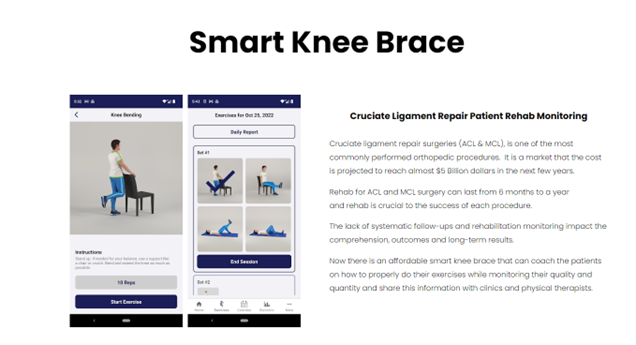Sensoria Smart Knee Brace and The Future of Rehabilitation
In the realm of orthopedics, knee braces have long been recognized for the crucial role that they have in providing support and stability to the knee. However, recent advancements delivered by Sensoria have brought about a new era of knee braces that incorporate sensors, offering enhanced functionality and monitoring capabilities.
Moreover, these technological breakthroughs have also paved the way for innovative developments in remote patient monitoring and tele-rehab technology, particularly in the areas of ligament support and prosthetic knee rehabilitation. Let us delve into the fascinating world of smart knee braces and explore the possibilities that lie within.
The role of knee braces in supporting and stabilizing the knee.
Knee braces play a vital role in supporting and stabilizing the knee joint, particularly for individuals recovering from injuries or those with chronic knee conditions. By providing external support, these braces help to alleviate pain, reduce inflammation, and promote healing. They work by exerting pressure on the affected area, distributing weight evenly, and limiting excessive movement that could further damage the knee.
Different types of knee braces are available, ranging from basic sleeves to more advanced hinged braces that offer additional stability. While knee braces are not a substitute for medical treatment or rehabilitation, they can be a valuable tool in aiding recovery and allowing individuals to regain mobility and resume their daily activities with increased confidence.
The use of sensors in smart knee braces for enhanced functionality and monitoring.
With the rapid advancement of technology, knee braces have evolved beyond their traditional role of support and stabilization. The integration of Sensoria Core Solo 2.0 sensors into knee braces has opened new possibilities for enhanced functionality and monitoring.
Sensors embedded within the braces can detect and analyze various parameters, such as range of motion, pressure distribution, and muscle activity. This real-time data can provide valuable insights into the wearer's movement patterns, gait analysis, and rehabilitation progress.
Additionally, the use of Sensoria Core Solo 2.0 sensors allows for personalized adjustments and customized feedback, ensuring optimal support and performance. Moreover, the ability to monitor and track data over time enables healthcare professionals to assess the effectiveness of treatment plans and make informed decisions regarding further interventions. Here’s the new Sensoria Core Solo 2.0 which can turn virtually any ‘dumb’ knee brace into a smart one:
The Sensoria SKB system can turn virtually any knee brace into a smart digital, connected tele-rehab system.
It is based on the integration of four main components:
1) Any “IoT ready” knee brace (we can turn any knee brace into a “smart-ready” knee brace).
2) An integrated wearable microelectronic device, Sensoria Core Solo 2.0.
3) A Physical Therapist (PT) focused cloud platform and a clinical side dashboard to monitor the patient remotely.
4) A patient-side smartphone application focused on knee rehab which includes interactive coaching on 14 different physical therapist’s prescribed exercises.
The data analyzed is obtained directly from the Sensoria microelectronics and its nine-axis inertial platform. The data is then ingested and calculated by specific machine learning and AI algorithms and is viewable, in different ways, through a clinician-side dashboard for remote monitoring and a patient-side mobile application, which allows a physical therapist to monitor the patient's adherence to the prescribed rehabilitation protocol in terms of number of exercises, number of repetitions of each exercise, range of motion of the knee, and other self-reported data from the patient (such as swelling or use of pain medication such as opioids).
Advancements in knee brace technology for ligament support and prosthetic knee rehabilitation.
Advancements in knee brace technology have revolutionized the field of ligament support and prosthetic knee rehabilitation. Traditional knee braces have been effective in providing stability, but recent developments have introduced innovative designs that specifically target ligament injuries. These braces incorporate advanced materials and mechanisms that mimic the function of the damaged ligaments, offering improved support and protection during movement.
Furthermore, prosthetic knee rehabilitation has seen significant advancements with the integration of knee braces. These braces work in conjunction with prosthetic limbs, providing enhanced stability and control, allowing individuals to regain mobility and perform a wider range of activities. The combination of advanced materials, biomechanics, and sensor technology has opened new possibilities for individuals with ligament injuries and those seeking prosthetic knee rehabilitation.
The continuous evolution of smart knee brace technology holds promising prospects for individuals with knee-related issues. Researchers and engineers are constantly exploring new materials, designs, and functionalities to further enhance the effectiveness and comfort of knee braces. Some of the exciting developments include the use of smart materials that can adapt to changes in movement and pressure, as well as the integration of artificial intelligence algorithms for real-time analysis and personalized treatment plans.
Additionally, advancements in 3D printing technology have made it possible to create custom-fit knee braces that offer optimal support and comfort. These ongoing advancements not only improve the functionality of knee braces but also contribute to the overall well-being and quality of life for individuals with knee conditions or injuries.
In conclusion, smart knee braces have come a long way in their role of supporting and stabilizing the knee. With the integration of sensors and advancements in technology, these braces now offer enhanced functionality, monitoring capabilities, and targeted support for ligament injuries and prosthetic knee rehabilitation. The future of smart knee brace technology holds even more exciting possibilities, promising improved outcomes and a better quality of life for individuals with knee-related concerns. Learn more about Sensoria SKB at: Smart Knee Brace — Sensoria Health or reach out at: info@sensoriahealth.com




